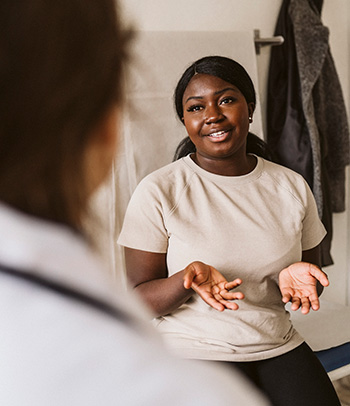When breast cancer is discovered early, it’s easier to treat successfully and the survival rate dramatically increases.
According to the National Cancer Institute, breast cancer is the second most common cancer in women in the United States, with roughly one in every eight women diagnosed during their lifetime.
Early detection makes treatment easier and improves survival rates. Getting regular screening tests, understanding the steps you can take to stay healthy, and accessing resources helps empower women to take control of their breast health and overall wellness.
Get Your Recommended Screenings
Although breast cancer screening cannot prevent breast cancer, it can help discover breast cancer early, when it is easier to treat.
Screening refers to tests and exams used to find a disease before symptoms appear. Breast cancers found during screening exams are more likely to be smaller and less likely to have spread outside the breast.
According to the Cleveland Clinic, the main screening test for breast cancer is a mammogram, which is a low-dose breast X-ray. A mammogram can often find breast changes that could be cancer years before physical symptoms develop. If something is found during your mammogram, your provider will go over your next steps with you.
The American Cancer Society has screening recommendations for women at average risk for breast cancer and for those at increased risk. For women at average risk, the recommendations are as follows:
- Women between 40 and 44 have the option to start screening with a mammogram every year.
- Women between 45 and 54 should get mammograms every year.
- Women 55 and older can switch to a mammogram every other year, or they can choose to continue yearly mammograms.
For women at increased risk (such as those with a strong family history, known genetic mutations like BRCA1/2, prior chest radiation, or certain high-risk breast conditions), screening may include annual mammograms and breast MRI, often starting earlier.
No matter your risk level, regularly scheduled screenings are key to detecting potential breast cancer at the earliest possible time. Talk to your health care provider about when you should begin routine screenings, as well as which breast cancer screenings are right for you based on your risk level.
Know Your Breasts
Knowing how your breasts normally look and feel can help you identify any changes or abnormalities in your breasts, such as new lumps or skin changes, that could possibly lead to cancer. Routine breast self-exams are not recommended for women at average risk, as studies show they do not lower breast cancer deaths and may lead to unnecessary tests. Instead, focus on breast awareness and report any changes.
Knowing your own breasts, along with knowledge of common symptoms associated with breast cancer, can help you notice any breast health changes, so you can alert your health care provider and schedule any necessary exams.
Breast cancer symptoms can include:
- Changes in breast size or shape
- Irritation or dimpling of the breast skin
- A new lump in the breast or armpit
- Nipple discharge other than breast milk
- Pain in any area of the breast
- Pulling in of the nipple or pain in the nipple area
- Redness or flaky skin in the nipple area or breast
- Thickening or swelling of part of the breast
Understand Your Risk Factors
 A person’s genes, lifestyle, and surrounding environment work together to increase or decrease our risk of getting cancer. The more you know about your risk factors, the better.
A person’s genes, lifestyle, and surrounding environment work together to increase or decrease our risk of getting cancer. The more you know about your risk factors, the better.
Risk factors for breast cancer can include:
- Older age
- Obesity
- Genetic risk of breast cancer, such as a family history of breast or ovarian cancer or a known genetic mutation such as the BRCA1 or BRCA2 gene
- Dense breast tissue
- Drinking alcohol
- A personal history of breast cancer or non-cancerous breast disease
- Previous treatment using radiation therapy to the chest
- Reproductive history, including early age at onset of periods, later age at menopause, or not having pregnancies
- Use of some hormones
It’s important to know your risk factors and to discuss them with your health care provider. This information helps you develop a plan for screenings and testing that’s right for you.
Make Healthy Choices
Certain risk factors like your age or your genetics are beyond your control, but other risk factors can be controlled through lifestyle choices. Adopting healthy habits can help you reduce your risk of developing many different cancers, including breast cancer. Here are a few habits to consider:
- Maintain a healthy weight. If you’re overweight, you are at higher risk of developing serious health problems, including certain cancers, heart disease, high blood pressure, and Type 2 diabetes.
- Move more. Studies show that women who are physically active have a lower risk of breast cancer than inactive women.
- Avoid smoking. Smoking is a risk factor for several types of cancer, including breast cancer.
- Limit your alcohol consumption. The more alcohol you drink, the greater your risk of developing breast cancer.
Access Important Resources
- Your TRICARE plan covers the breast care services and resources you need, including clinical breast exams and annual mammograms for all women who are age 40 or older, and for women age 30 and older who are at high risk. Other breast services include annual breast MRIs and genetic counseling for women with certain risk factors.
- The Department of Veterans Affairs provides access to breast care resources, including screening and mammogram services, breast ultrasounds and MRI, breast biopsy and surgery, genetic counseling and testing, cancer diagnosis, and treatment.
Breast cancer awareness means getting recommended screenings, knowing your risk factors, practicing breast awareness, and making healthy choices. Early detection saves lives—empower yourself to take charge of your breast health.







